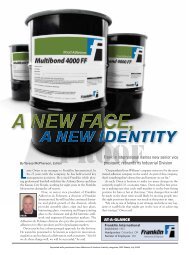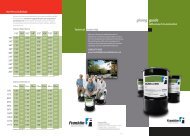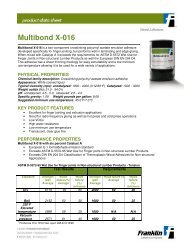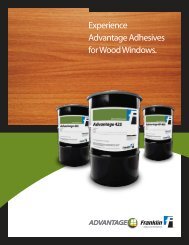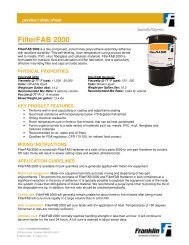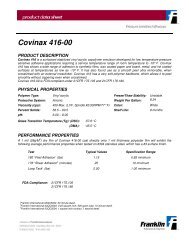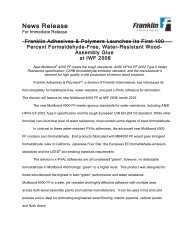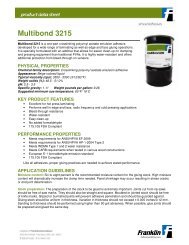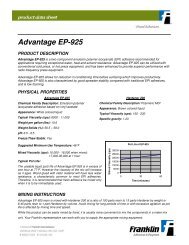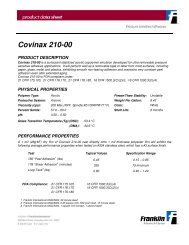Titebond 50 - Franklin Adhesives and Polymers
Titebond 50 - Franklin Adhesives and Polymers
Titebond 50 - Franklin Adhesives and Polymers
Create successful ePaper yourself
Turn your PDF publications into a flip-book with our unique Google optimized e-Paper software.
_<br />
<strong>Titebond</strong> <strong>50</strong><br />
<strong>Titebond</strong> <strong>50</strong> is a ready to use aliphatic resin emulsion adhesive. For over 55 years,<br />
it has been the premier choice for bonding wood substrates. It is fast setting <strong>and</strong> has<br />
excellent heat resistance. <strong>Titebond</strong> <strong>50</strong> can be used in edge <strong>and</strong> face gluing <strong>and</strong><br />
general assembly applications for interior use. It also performs well in conventional<br />
cold press equipment.<br />
PHYSICAL PROPERTIES<br />
Chemical family description: Polyvinyl acetate emulsion adhesive<br />
Appearance: Yellow colored<br />
Typical viscosity (cps): 3000 - 4<strong>50</strong>0<br />
Weight solids (%): 44.2 - 47.0<br />
pH: 4.0 -5.0<br />
Specific gravity: 1.15 Weight pounds per gallon: 9.60<br />
Suggested minimum use temperature: 35°F/ 2°C<br />
KEY PRODUCT FEATURES<br />
• One-component great for cold pressing <strong>and</strong> assembly<br />
• Proven history of performance without compromise for interior furniture<br />
• Excellent heat <strong>and</strong> solvent resistance<br />
• Fastest setting aliphatic resin adhesive<br />
• No formaldehyde<br />
• 175.105 FDA Compliant<br />
PERFORMANCE PROPERTIES<br />
• Meets DIN EN 14257 WATT 91 Heat Testing<br />
Method<br />
Temperature<br />
(˚C)<br />
Minimum required<br />
average value<br />
(N/mm 2 )<br />
7<br />
(Recommended St<strong>and</strong>ard)<br />
DIN EN 14257<br />
80<br />
(WATT 91)<br />
*Rosenheim reports <strong>50</strong>5 44211/4e 9/21/2010 <strong>and</strong> <strong>50</strong>5 44211/1e 9/21/2010<br />
Average value<br />
(N/mm 2 )<br />
Wood<br />
Failure (%)<br />
9.4 100<br />
APPLICATION GUIDELINES<br />
Moisture content: Six to eight percent is the recommended moisture content for the gluing stock. High moisture<br />
content will dramatically increase the clamp time needed. Panel shrinkage may occur resulting in stress cracks<br />
or end-joint delamination.<br />
Stock preparation: The preparation of the stock to be glued is extremely important. Joints cut from rip saws<br />
should be free of saw marks. They should also be straight <strong>and</strong> square. Moulded or jointed stock should be free<br />
of knife marks. Glazed or burnished joints will prevent adhesive penetration <strong>and</strong> should be guarded against.<br />
Gluing stock should be uniform in thickness. Variation in thickness should not exceed ± 0.005 inches/0.12 mm.<br />
S<strong>and</strong>ing to thickness should be performed using higher than <strong>50</strong> grit abrasives. When possible, glue joints should<br />
be prepared <strong>and</strong> glued the same day.
Page 2 of 3<br />
Spread: Generally, 35-<strong>50</strong> pounds of adhesive per 1,000 square feet or 170-2<strong>50</strong> grams per square meter of glue<br />
line is adequate. Verify adequate glue coverage by monitoring for squeeze out along the glue line once the<br />
panels are under pressure. A Web based spread calculator can be found at<br />
www.franklinadhesives<strong>and</strong>polymers.com.<br />
Pressure: Pressure is dependent upon the species or material to be glued <strong>and</strong> joint preparation. Direct contact<br />
of the gluing surfaces is required to obtain maximum strength. The use of a compressometer will aid in<br />
accurately measuring the amount of pressure being applied to the gluing area. Suggested clamp locations for<br />
various wood densities are eight to fifteen inches (20-38 cm) apart <strong>and</strong> two inches (five cm) from the end of the<br />
panel to evenly distribute pressure along the entire length of the glue line. A Web based pressure calculator can<br />
be found at www.franklinadhesives<strong>and</strong>polymers.com.<br />
Assembly time: The assembly time is influenced by many factors some of which include glue spread, moisture<br />
content of the stock, porosity of the stock, environmental conditions <strong>and</strong> adhesive choice. Assembly times of five<br />
to ten minutes are approximate. It is desirable to see a bead of adhesive squeeze out around the perimeter of<br />
the bottom panel of the stack.<br />
Press/clamp time: Press times are dependent on the adhesive used, gluing stock type, moisture content of the<br />
stock, <strong>and</strong> environmental conditions. Press times can range from a minimum press time of 30 minutes to greater<br />
than two hours. Shorter times are required under ideal conditions when using soft wood species at moisture<br />
content slightly less than eight to ten percent <strong>and</strong> factory temperatures of 68 degrees Fahrenheit/ 20 degrees<br />
Celsius. Longer press times will be required for higher density species, higher moisture contents <strong>and</strong> colder<br />
factory temperatures. It is recommended that optimum press times be determined in actual plant conditions<br />
recognizing that seasonal changes may lead to variable requirements.<br />
Machining/ post process conditioning: After the minimum clamping time period, the panel will develop<br />
enough h<strong>and</strong>ling strength <strong>and</strong> can be removed <strong>and</strong> stacked out of the press. Twenty four hours of cure is<br />
recommended before further machining. Three or four days may be required to eliminate sunken joints caused<br />
by residual moisture in the glue line.<br />
Minimum use temperature: Curing temperatures should be higher than the minimum use temperature of the<br />
adhesive. This includes the temperature of the stock to be glued as well as the air <strong>and</strong> adhesive temperatures.<br />
If the temperatures are below the minimum use temperatures you will see a white, chalky appearance of the<br />
glueline. These bonds are usually weak.<br />
Clean-up: For easy removal of adhesive from equipment, clean up while it is still wet with warm water (this<br />
includes the glue roller <strong>and</strong> pans). For dried glue, steam <strong>and</strong> or hot water are the most effective. Using glue<br />
release agents on equipment will also allow for easier clean up.<br />
STORAGE AND HANDLING<br />
Shelf life: Best if used within twelve months of date of manufacture. Mix before use. Product is not freeze thaw<br />
stable. Frozen product will have a separated <strong>and</strong> or lumpy appearance.<br />
For additional questions, <strong>Franklin</strong>’s technical service team is available at 1.800.877.4583. 24/7 technical service<br />
is available online at www.franklinadhesives<strong>and</strong>polymers.com<br />
IMPORTANT NOTICE TO CUSTOMER:<br />
The recommendations <strong>and</strong> data contained in this Product Data Sheet for use of this product are based on information <strong>Franklin</strong> believes to<br />
be reliable. They are offered in good faith without guarantee, as conditions <strong>and</strong> methods of use of our product by Customer are beyond
Page 3 of 3<br />
<strong>Franklin</strong>’s control. Customer should determine the suitability of the product for a particular application before adopting it on a commercial<br />
scale. Discoloration <strong>and</strong> checking of wood veneer materials may occur with use of the product. These occurrences range in appearance,<br />
color <strong>and</strong> may also vary depending upon the species of wood veneer to which the product is applied. Such discoloration <strong>and</strong> checking may<br />
appear during or after the manufacturing process which utilizes the product. Environmental conditions in some manufacturing plants <strong>and</strong><br />
end-use locations can contribute to discoloration <strong>and</strong> checking. Because such discoloration <strong>and</strong> checking are attributable to conditions<br />
beyond <strong>Franklin</strong>’s control, <strong>Franklin</strong> cannot assume any responsibility or liability for any discoloration <strong>and</strong>/or checking problems that might<br />
occur.<br />
All orders for <strong>Franklin</strong> products shall be subject to <strong>Franklin</strong> International, Inc.’s St<strong>and</strong>ard Terms <strong>and</strong> Conditions of Sale which may be found<br />
at http://www.franklini.com/Terms_<strong>and</strong>_Conditions.aspx (“St<strong>and</strong>ard Terms”). Different or additional terms proposed by Customer are<br />
expressly rejected <strong>and</strong> shall not become part of the agreement between Customer <strong>and</strong> <strong>Franklin</strong> International, Inc. with respect to any order.<br />
Contact <strong>Franklin</strong> International, Inc. immediately if you cannot access our St<strong>and</strong>ard Terms <strong>and</strong> we will provide you a copy upon request. Any<br />
sale of products by <strong>Franklin</strong> to Customer is expressly conditional upon Customer’s consent to the St<strong>and</strong>ard Terms, <strong>and</strong> Customer’s<br />
acceptance of any performance by, or receipt of products from, <strong>Franklin</strong> International, Inc. shall constitute Customer’s acceptance of the<br />
St<strong>and</strong>ard Terms <strong>and</strong> Conditions of Sale.<br />
©Copyright 2014. All rights reserved. <strong>Franklin</strong> International. Revised 02/19/14.



